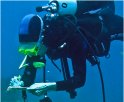
Geographic Information Systems and IT solutions for the environment

Mappamondo GIS is ready to share its experience with you! Tell us what are your development directions and we will provide the learning path that best suits you, your department and your industry! Let us show you how GIS are being used around the world in your industry and how everything that seemed impossible to you or hard to achieve is now only a few mouse clicks away! We offer a wide range of training and professional development tools through qualified instructors. The following courses are delivered at Introductory, Intermediate and Advanced level. The programs contained in the pdf files are for the Standard and Introductory level courses. For Intermediate, Advanced and "on-demand" programs please contact us.

Dive GIS 2011 - 31 July - 10 August
The early bird enrolment to the 6th edition of this unique course is now open!
Dive GIS course is for you if you wish to: